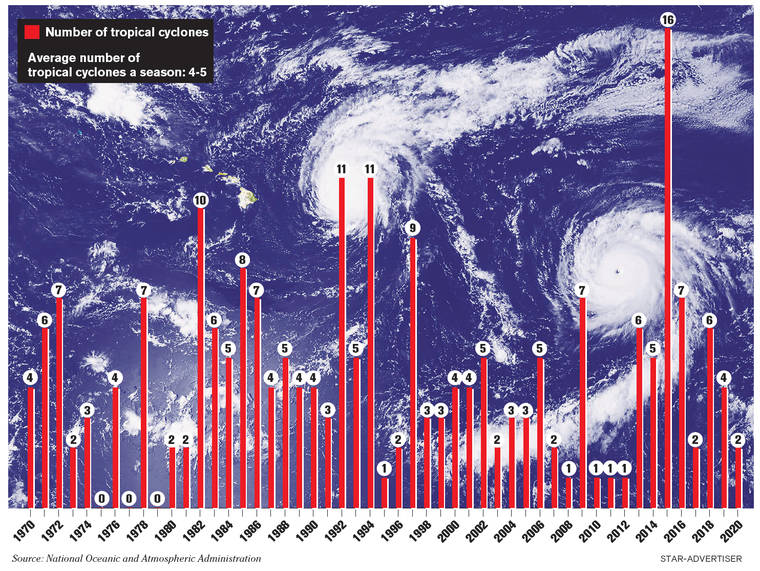It could be another lackluster year for hurricanes in the waters around Hawaii.
The Central Pacific Hurricane Center on Wednesday predicted that the region will see two to five tropical cyclones during the hurricane season that starts June 1.
During a virtual news conference, forecasters said there’s an 80% chance for a near-normal or below- normal hurricane season.
The Central Pacific typically sees an average of four to five storms each year, but last year only two cyclones found their way into our waters.
Matthew Rosencrans, lead seasonal hurricane forecaster at the National Oceanic and Atmospheric Administration’s Climate Prediction Center, said there will likely be less storm activity in the Central Pacific, compared to more-active seasons.
The reason, he said, is because ocean temperatures are expected to be near average to below average in the central and eastern tropical Pacific Ocean, where hurricanes form, and because El Nino is not present to allow for conditions that will increase cyclone activity.
On the other hand, the active phase of the Pacific decadal oscillation, a pattern of climate variability over the mid-latitude Pacific basin, is continuing and may help to balance out the forecast.
“To the extent that this will counterbalance those negative factors gives some uncertainty to our seasonal outlook,” said Chris Brenchley, director of the Central Pacific Hurricane Center.
Brenchley added that the forecast is not a prediction of hurricane landfalls but only the number of cyclones — including tropical depressions, tropical storms and hurricanes — expected in the north Central Pacific basin extending from 140 degrees west to the international dateline (180 degrees).
Last month a Honolulu-based climate forecasting and risk management company released its storm forecast for the season, and it is not too different from the Central Pacific Hurricane Center forecast.
AbsoluteClimo is predicting only one to two hurricanes for the north Central Pacific during the upcoming season. The company’s forecast does not include any storm less than hurricane strength.
“We really won’t look like 2018,” said climatologist Brendan Lane Larson, co-founder and CEO of AbsoluteClimo.
In 2018 the Central Pacific basin experienced six powerful hurricanes, including hurricanes Lane and Olivia, making it one of the most active seasons on record for the basin.
Larson said the 2021 season should see average ocean temperatures and close-to-normal upper-level wind shear, which should help to make it a pretty average season.
Still, officials on Wednesday cautioned Hawaii residents to get prepared now for the upcoming season, which extends through Nov. 30.
They urged residents to have a 14-day supply of nonperishable food and water.
“Disasters don’t wait. Neither should you,” said Robert Fenton, administrator of Region 9 of the Federal Emergency Management Agency.
“As we’ve experienced in previous hurricane seasons, it only takes one direct hit, as in 1992 with Hurricane Iniki, or even a close call, as in last year with Hurricane Douglas, to have a major impact on daily life here in the Hawaiian islands,” Brenchley said.
Although last year was a below-normal season, Hurricane Douglas churned uncomfortably close to Hawaii in late July. It passed Oahu about 30 miles north of Kahuku, making it the closest a hurricane has come to Oahu since before Hurricane Dot in 1959.
Meanwhile, a consensus of NOAA’s Climate Prediction Center’s climate models would suggest below-normal precipitation in Hawaii throughout the summer dry season.
“This means that the existing areas of drought in Maui County and the Big Island are expected to worsen and expand,” said Kevin Kodama, National Weather Service hydrologist.
Kodama said those areas could experience extreme drought by the end of September, while new areas of drought could start to develop in the leeward regions of Oahu and Kauai, mainly affecting the agriculture sector.
Even some windward areas could experience moderate to severe drought, with water systems dependent on surface water and rain catchment the most vulnerable, he said.
As for the recently concluded 2020-2021 wet season, Hawaii experienced the eighth wettest wet season in the last 30 years, Kodama said, following a period of above-average rainfall, especially on Kauai and Oahu.
HURRICANE PREPARATION
>> 1. Gather emergency supplies, including a 14-day supply of nonperishable food and water, plus medicine. Prepare a go-bag if evacuation is part of your plan.
>> 2. Have an emergency plan and know where you will shelter.
>> 3. Work on your house. Low-cost action items include:
a. Clearing debris, clutter and junk from your yard and from gutters, downspouts and drainage ways.
b. Maintaining your house by preventing wood rot and termite damage.
c. Adding hurricane clips (generally to houses built before 1988 on Oahu, 1990 on Maui and Kauai, and 1994 in Hawaii County).
e. For more items, download free Homeowners Handbook to Prepare for Natural Hazards (4th Edition).
>> 4. Checking your insurance coverage, both hurricane and flood. These cannot be purchased during an impending event.
Source: University of Hawaii Sea Grant Program




